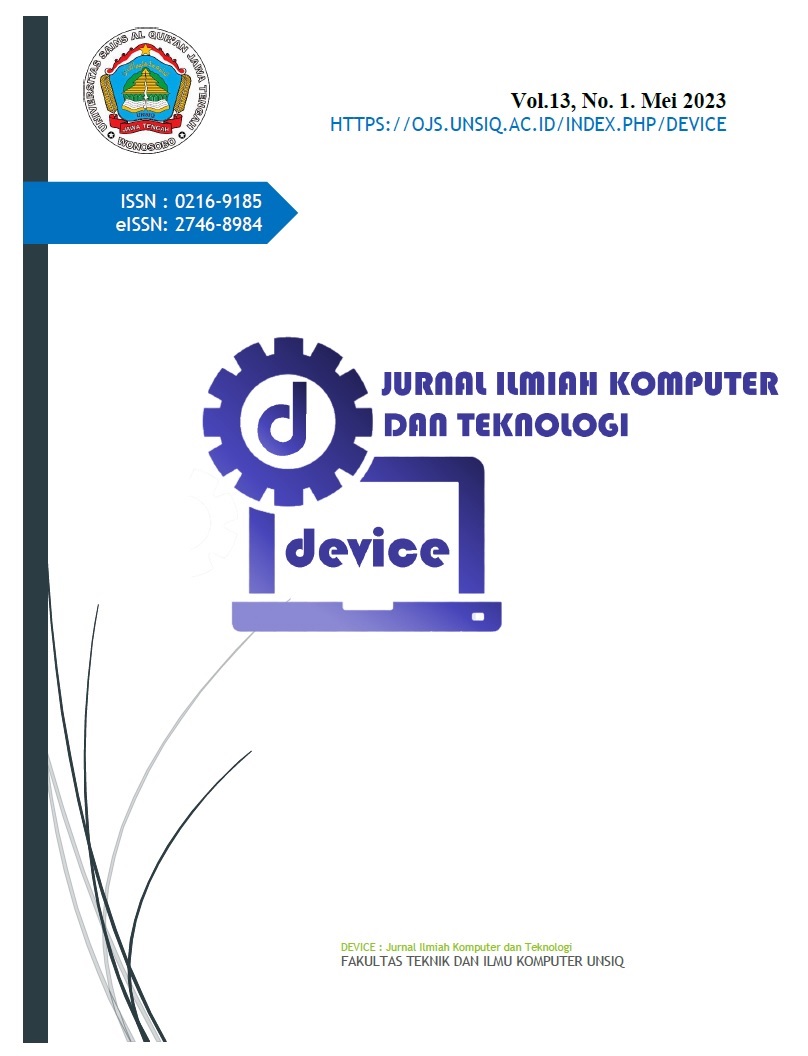IMPLEMENTASI ALGORITMA TF-IDF DAN SUPPORT VECTOR MACHINE TERHADAP ANALISIS PENDETEKSI KOMENTAR CYBERBULLYING DI MEDIA SOSIAL TIKTOK
DOI:
https://doi.org/10.32699/device.v13i1.5260Keywords:
Cyberbullying Comments, Machine Learning, TF-IDF, SVMAbstract
Cyberbullying is the act of sending text, images, or videos using the internet, mobile phones, or other devices with the aim of hurting and shaming other people. Cyberbullying is often done through several social media platforms, one of which is through comments on the TikTok application. According to a report by We Are Social, TikTok has 1.4 billion monthly active users aged 18 and above globally. Indonesia currently ranks second in the world in terms of active TikTok users. As a result, the potential for cyberbullying instances will grow as the number of users grows. By using data mining, the public can create a detection system, which can perform analysis on comments in the TikTok application. The method used is Term Frequency-Inverse Document Frequency (TF-IDF) and Support Vector Machine (SVM). The stages passed are to collect comments that are labelled manually. Then, text preprocessing, tokenizing, and weighting were carried out with TF-IDF. Then, implement the Support Vector Machine algorithm to detect cyberbullying comments. This study uses 80% training data and 20% testing data. From the performance results of the Support Vector Machine algorithm, 88% overall accuracy, 88% precision, 96% recall, and 92% f1-score were obtained in detecting cyberbullying comments on social media TikTok.
References
Juditha, C. (2021) ‘ANALISIS KONTEN TENTANG PERUNDUNGAN MAYA TERHADAP SELEBRITI DI INSTAGRAM ANALYSIS OF CONTENT THE CASE OF CYBERBULLYING AGAINST CELEBRITIES ON INSTAGRAM’, Jurnal Penelitian Komunikasi dan Opini Publik Vol, 25(2), pp. 183–198.
Kamal, R.M. (2019) Analisis Sentimen Cyberbullying Pada Komentar Facebook Dengan Metode Klasifikasi Support Vector Machine. Universitas Komputer Indonesia.
Manoppo, T.N. and Fudholi, D.H. (2021) ‘Deteksi Cyberbullying berdasarkan Unsur Perbuatan Pidana yang Dilanggar dengan Naive Bayes dan Support Vector Machine’, J-SAKTI (Jurnal Sains Komputer dan Informatika), 5(1), pp. 10–19.
Mitsu, R. and Dawood, E. (2022) ‘Cyberbullying: An Overview’, Indonesian Journal of Global Health Research, 4(1), pp. 195–202. Available at: https://doi.org/10.37287/ijghr.v4i1.927.
Monavia Ayu Rizaty (2022) Pengguna Tiktok Indonesia Terbesar Kedua di Dunia, https://dataindonesia.id/digital/detail/pengguna-tiktok-indonesia-terbesar-kedua-di-dunia.
Pardede, J., Miftahuddin, Y. and Kahar, W. (2020) ‘Deteksi Komentar Cyberbullying Pada Media Sosial Berbahasa Inggris Menggunakan Naïve Bayes Classification’, JURNAL INFORMATIKA, 7(1). Available at: http://ejournal.bsi.ac.id/ejurnal/index.php/ji.
Puspitarini, D.S. and Nuraeni, R. (2019) ‘Pemanfaatan media sosial sebagai media promosi’, Jurnal Common, 3(1), pp. 71–80.
Qaiser, S. and Ali, R. (2018) ‘Text Mining: Use of TF-IDF to Examine the Relevance of Words to Documents’, International Journal of Computer Applications, 181(1), pp. 25–29. Available at: https://doi.org/10.5120/ijca2018917395.
Ritonga, A.S. and Purwaningsih, E.S. (2018) ‘Penerapan Metode Support Vector Machine (SVM) Dalam Klasifikasi Kualitas Pengelasan Smaw (Shield Metal Arc Welding)’, Jurnal Ilmiah Edutic: Pendidikan dan Informatika, 5(1), pp. 17–25.




















